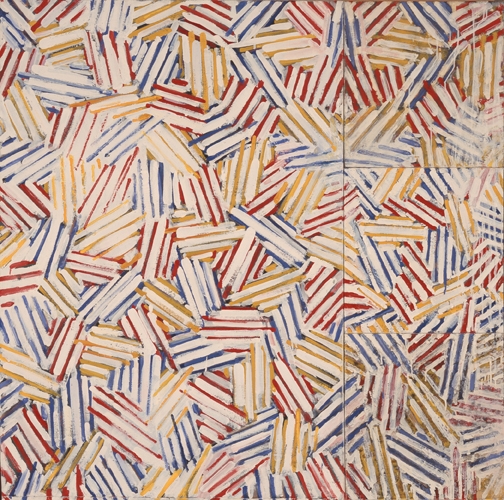Could Jasper Johns be the most strategic of conceptual painters working today? By strategic I mean the most calculated, the most perceptually acute and the most decisive, particularly at a moment when painting – one might say the enterprise of art in general – can’t decide on its purpose, save some weak sense that it’s locked in a game with its own history, one that still allows for cursory gestures at self-expression when not succumbing to decorative self-conscious formalism. On the evidence of ‘Something Resembling Truth’ at The Broad, the only US venue for this thematic exhibition of Johns’s work (organised by London’s Royal Academy of Art), I’d wager that this is the case. And it takes a show such as the current one to demonstrate how Johns’s strategies – reticence, irony, quotation; they’ve gone by many labels – have all been marshalled towards the renewal of how it is that painting might come to mean anything at all.
Let’s begin with Johns’s Catenary series (1997–2003), one of the artist’s most recent. These works have been nearly universally lauded since they first appeared in 2005 in the artist’s first solo exhibition with Matthew Marks (itself something of a strategic move given the painter’s long association with dealer Leo Castelli). That’s where I first saw them, and I didn’t like them. There was something about the precarious awkwardness of the hinged slats that lean off the sides of many of the works, and the seeming hobby-store quality of the hanging strings, whose curves give the series its name, which didn’t seem either well designed or fully intended. These works just didn’t cohere, and most of Johns’s work had been nothing if not coherent, sometimes internally so (e.g. the Targets, 1955–), and sometimes in conspiracy with the viewer (The Critic Sees, 1961, or Painting with Two Balls, 1960).
In a work such as Bridge (1997) that awkwardness remains, but the incoherence now reads more like a necessary feature of the work, as when the challenges of intellectual inquiry or research remain as yet unresolved. I’m sure this is what Johns is after: the venture of thinking, as it tarries over the rules of its own delicate physicality (the string, the slats), grounded, as it were, by the generic images of thought – the painted mimesis of the frame’s wood grain, the painted picture of a stellar galaxy, the symbol of the Big Dipper, the harlequin pattern, the word ‘BRIDGE’ – all different means and modes of representing, of disciplining the riot of the real and making something meaningful.
Perhaps this search began in the mid-1980s, with Johns’s cycle The Seasons (1985–86), in which picturing this venture of thought required a detour through picturing something like a self – hard to commit to it being Johns’s self – through references to some of the artist’s earlier image strategies (flags, devices) as well as icons of philosophical thinking such as the Platonic forms, Joseph Jastrow’s duck-rabbit diagram (the latter made famous by Ludwig Wittgenstein’s inquiry into ‘seeing as’ in the Philosophical Investigations, 1953) and Pliny’s origin story of the birth of painting as the tracing of a loved-one’s silhouette in shadow.
It is quite possible that all of this is thrown into the work to throw us off the scent of its meaning – like cleverness that covers up a fear of hard thinking, or a wilful determination not to state what the work is about, which is what defines so many of Johns’s iconic image-strategies of the 1960s. But in light of the last 30 years, Johns’s work now seems defined, or rather challenged, by the prospect, the very real difficulty, of how making paintings – how making art – can be considered a means of making the obdurate stuff of the world, including such obdurate stuff as words and marks, meaningful.
Jasper Johns: ‘Something Resembling Truth’, The Broad, Los Angeles, 10 February – 13 May 2018
From the May 2018 issue of ArtReview
